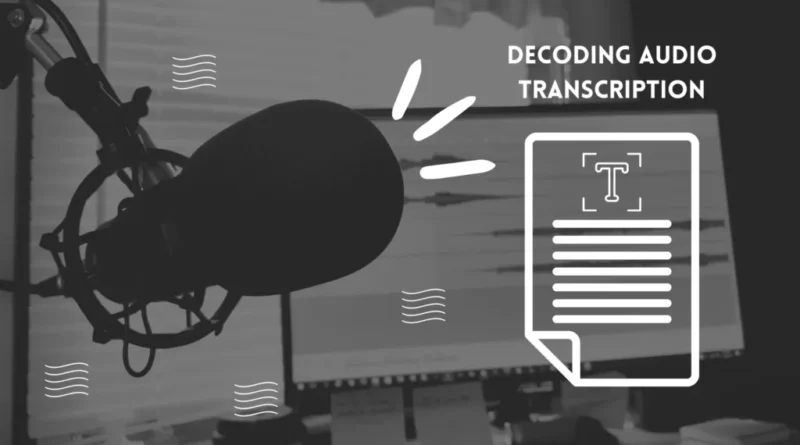A Deep Dive into Audio Content Decoding Technology
A Deep Dive into Audio Content Decoding Technology
In an era marked by a growing appetite for multimedia content, audio content decoding technology plays a crucial role in delivering high-quality sound experiences across various platforms. From streaming music and podcasts to watching videos and playing video games, audio decoding is the unsung hero that ensures the audio we hear is crisp, clear, and free from glitches. ML-based audio document generation In this article, we’ll take a deep dive into audio content decoding technology, exploring its significance, underlying principles, and its impact on our daily lives.
Understanding Audio Content Decoding
Audio content decoding, often referred to as audio decoding or audio codec, is the process of converting encoded audio data back into its original, audible form. This conversion allows us to hear the sounds, music, voices, and other audio components of the multimedia content we consume. In essence, audio decoding acts as a bridge that connects digital audio files or streams to the speakers or headphones, making the content perceivable to our ears.
The Role of Audio Codecs
Audio codecs, short for “compression-decompression” algorithms, are at the heart of audio content decoding. These codecs are responsible for compressing audio data for efficient storage and transmission, and then expanding it back into audio when needed. Without audio codecs, digital audio files would be unwieldy, making it impractical to store and transmit them over the internet.
Key Components of Audio Content Decoding
To fully grasp the technology behind audio content decoding, it’s essential to understand its key components:
1. Encoding
Audio content decoding begins with the encoding phase, where the original audio signal is transformed into a digital format. This process samples the analog audio signal at regular intervals and quantizes it into discrete values. The resulting digital audio file is significantly smaller in size than its analog counterpart.
2. Compression
Compression is the cornerstone of efficient audio storage and transmission. It reduces the size of the digital audio file by removing redundant or unnecessary data, thus lowering the bandwidth required to transmit it. Common audio codecs like MP3 and AAC use lossy compression techniques, which discard some audio data that is considered less essential, while others, like FLAC and ALAC, employ lossless compression that preserves all the original audio data.
3. Decoding
Decoding is the process of reversing the compression and returning the digital audio file to its original form. This step is crucial for playback, as it allows the audio to be heard through speakers or headphones.
4. Playback
Playback is the final step in the audio content decoding process. It involves sending the decoded audio data to a device’s sound output system, which can be speakers, headphones, or any audio playback equipment. The playback system converts the digital audio signal back into sound waves that can be heard by the human ear.
Impact on Multimedia Experiences
Audio content decoding technology is integral to our daily interactions with multimedia content. Whether you’re streaming a movie on Netflix, listening to music on Spotify, or engaging in video conferencing, the quality of the audio decoding technology greatly influences your overall experience. When audio decoding is seamless and efficient, you get to enjoy high-fidelity sound, clear dialogues, and an immersive auditory experience. On the other hand, if audio decoding is subpar, you might encounter issues such as audio dropouts, artifacts, or distorted sound.
Advancements in Audio Decoding Technology
As technology advances, so does audio content decoding technology. With the advent of high-resolution audio and the proliferation of virtual reality (VR) and augmented reality (AR), there’s a growing demand for more sophisticated audio codecs and decoding techniques. Here are some of the key trends in audio decoding technology:
1. Object-Based Audio
Object-based audio is a concept that allows individual audio elements, like voices or sound effects, to be treated as separate objects. This technology enables a more personalized and interactive audio experience, as users can adjust the volume or position of specific audio objects in real-time.
2. Immersive Audio Formats
Immersive audio formats, such as Dolby Atmos and DTS:X, offer a three-dimensional audio experience, creating a more immersive and realistic soundscape. These formats demand advanced audio decoding capabilities to reproduce spatial audio accurately.
3. Low-Latency Audio Decoding
Low-latency audio decoding is crucial for real-time applications like online gaming and video conferencing, where even the slightest delay can be disruptive. Advanced audio codecs are being developed to minimize latency and ensure a seamless audio experience.
4. Audio Accessibility
Audio content decoding technology is also being leveraged to enhance audio accessibility for individuals with hearing impairments. Subtitling, closed captions, and audio description services rely on sophisticated decoding and synchronization techniques to make multimedia content inclusive for all.
Conclusion
Audio content decoding technology may not be as glamorous as high-definition screens or cutting-edge visual effects, but it’s a silent hero that underpins our multimedia experiences. Without efficient and advanced audio decoding, our interaction with music, movies, video games, and video conferences would be far less enjoyable. As technology continues to evolve, so too will audio decoding, ensuring that our auditory experiences remain as rich and immersive as ever. So, the next time you enjoy your favorite song or watch a thrilling movie, remember that audio content decoding technology is working tirelessly behind the scenes to bring sound to life.
